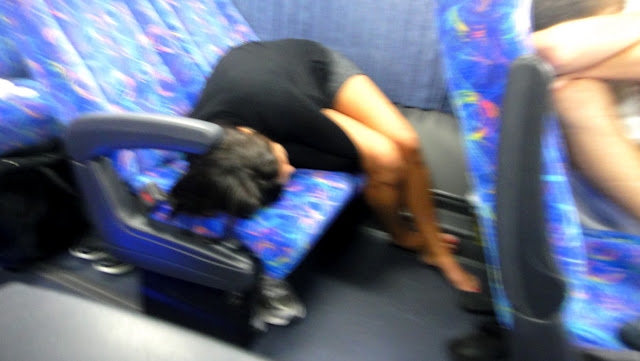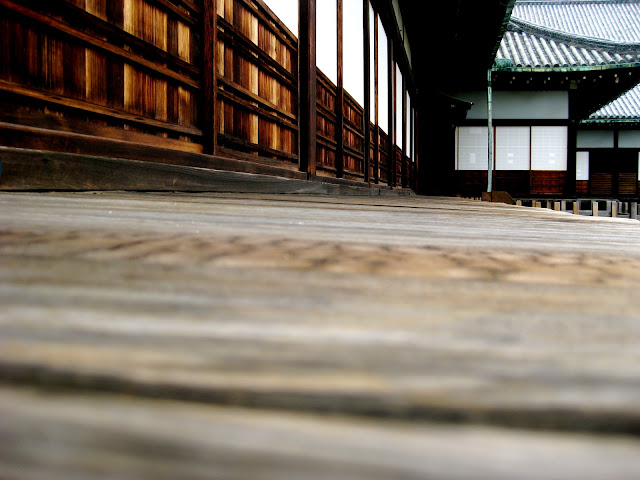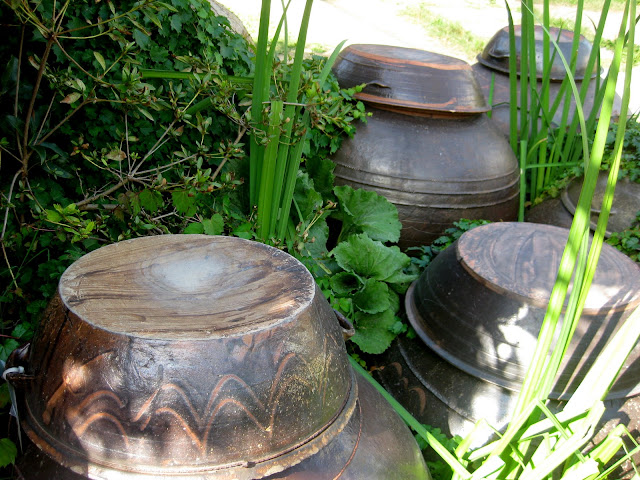The Chuseok holiday of late September seems like a lifetime ago. Looking back on the pictures I remember the hot, sticky humidity that has since been replaced by a chilly wind. It’s been so long that we’re definitely ready for another vacation, but that’s a different story. I’m finally getting around to sharing the trip we took during the holiday (sorry!) so here goes.
Inside the fluorescently lit but cozy little joint, seemingly unlimited varieties of colorful and fresh sushi, juice boxes, fruit and desserts circled around the winding conveyor belt. The booths were full, so we sat at the counter in true sushi style. After struggling to figure out the correct way to order from the computer screen above our seats, a young (English speaking) woman came to our rescue. She explained that if something we wanted was unavailable on the conveyor, we could order it from the screen. Soon it would arrive on a small train, an exact replica of the one we’d ridden earlier on our return trip from Hiroshima.
Ancient structures lined with golden statues and complicated woodwork surrounded us.
Replicas of royalty set the scene inside the beautiful building, where unfortunately no pictures were allowed.
Our final stop after leaving the castle was still more souvenir shopping at the Kyoto handicraft center, where artistic vendors created one of a kind paintings, jewelry and pottery within its walls.
The three of us (Ryan’s mom Sarah, Ryan and I) departed early for Japan on the first day of our six day vacation from work. On the airplane we studied survival Japanese, trying not to confuse the new vocabulary with the little Korean we’ve acquired. As we caught our first glances of the islands from the airplane window, we knew we’d love our destination.
Kyoto
Soon we arrived in in Kansai, Osaka’s airport.
We immediately set off by train for Kyoto and were approached by an English-speaking Japanese father and son, who initiated a friendly conversation with us. It was clear we weren’t in Korea anymore, where unfortunately even smiles from strangers are often rare. We changed trains, exchanged money, and attempted to gauge where we were in our new city. We noticed numerous Japanese cars which we don’t see many of in Korea.
We immediately set off by train for Kyoto and were approached by an English-speaking Japanese father and son, who initiated a friendly conversation with us. It was clear we weren’t in Korea anymore, where unfortunately even smiles from strangers are often rare. We changed trains, exchanged money, and attempted to gauge where we were in our new city. We noticed numerous Japanese cars which we don’t see many of in Korea.
Beautiful calligraphy caught our eye as well.
On nearly every street corner we saw signs for Pachinko within small casinos. Bright lights lured in potential gamblers. In retrospect I wish we’d have tried it, but we had lots on our to-do list.
The woman who ran it was extremely friendly. She greeted us with a welcoming smile and led us to our upstairs room.
After dropping off our bags, we found the kitchen, sitting area, bathroom and shower on the first floor.
After dropping off our bags, we found the kitchen, sitting area, bathroom and shower on the first floor.
It was kind of like living in a sorority again, with the exception of these.
The hostel provided kimonos for photo ops.
Our first night consisted of searching for the perfect (and highly anticipated) Japanese food. What we found instead was battered pork, overpriced miso soup and unnecessarily fancy sushi. At least it was tasty.
Our first night consisted of searching for the perfect (and highly anticipated) Japanese food. What we found instead was battered pork, overpriced miso soup and unnecessarily fancy sushi. At least it was tasty.
We hit the grocery store after dinner so we’d have cheaper snacks on hand.
There were beautiful produce displays and a much larger selection of imported foods than we’re used to finding in Busan.
THERE WERE LIMES. I repeat: THERE WERE LIMES.
There were also many cold coffee drinks similar to those we find in Korea, but this one was closer to home than any others we’ve seen.
We purchased lunch for the next few days and fell asleep wrapped in warm blankets atop our cozy cushioned floor beds.
Nara
The next day, we headed out early to spend our first full day in nearby Nara and its surrounding areas.
Once we’d arrived in the city by train, wooden temple Horyuji was our first stop. Since it was located outside of the city, we got on a bus and hoped we were heading for the right place. Rather than paying a flat fare, a ticket was dispensed for passengers to take upon boarding. A meter at the front of the bus showed the amount due for those who had gotten on at each stop. The three of us cringed as we watched the meter on the bus quickly increase. I have to say, even though we were warned before our trip, the incredible cost of transportation (not to mention everything else in Japan) was hard to believe (and afford).
The long, expensive trip to Horyuji proved to be worthwhile, with beautiful and well-preserved wooden structures unlike those we’ve seen in Korea’s temples. Horyuji is the oldest Buddhist temple in Japan and its buildings are the oldest wooden structures in the world.
We decided to represent the Blazers for the day, sporting shirts with our local team’s logo.
After our return to Nara proper, we set out to find Todaiji, another well-known temple. We passed an unenclosed deer park where we stopped to interact with the friendly, adorable animals. They explained the city’s strange mascot, a chubby cartoon boy with antlers. (See picture above).
The docile deer extended the next five or six blocks leading into the temple.
The temple was constructed in 752 AD, and although it has been torched twice during wars, it has been reconstructed as a place of prayer and peace. Ceremonies are frequently held there, some dating back to one thousand years ago.
Home to the largest indoor Buddha in the world, Todaiji’s Buddha is second in size only to an outdoor statue that stands in China. The statues were as tall as the sky and truly breathtaking to see in person.
This odd looking Buddha of sorts resides outside.
Those with health problems are encouraged to rub the body part on the statue that ails them. If they then touch their own corresponding body part, it is said that they will be healed.
We hurried back to the train at sunset, weaving through souvenir and clothing shops on the way.
Hiroshima
The reason for our hurry was a night bus, which would be departing from the train station back in Kyoto. It took us to Hiroshima in an incredibly long nine hours, but saved us over $150 as a substitute for the bullet train.
We tossed and turned in the cramped seats as passengers shuffled on and off the bus.
After a mostly sleepless night, we arrived at the train station in Hiroshima, where we got ready in the bathroom and discussed our day’s plan over coffee at a small café.
A tourist friendly cable car dropped us off directly in front of the massive Hiroshima Memorial and Peace Park, just as a downpour began.
The first structure we saw was a hollow shell of a building, preserved just as it was on August 6, 1945 when the bomb was dropped on the unsuspecting city. Appropriately renamed “The A-Bomb dome,” the building stood standing due to its strong steel structure. Registered as a UNESCO World Heritage Site in 1966, the dome is meant to serve as a reminder of the first nuclear bomb in history. It is also a symbol of Hiroshima’s hope that the world will abolish all nuclear weapons and someday realize worldwide peace.
Just past the A-Bomb Dome were thousands of folded paper cranes encased in plastic.
Known as the Children’s Peace Monument, it is a memorial for every child who died as a result of the bombing.
The monument was inspired by Sadako Sasaki, a two year old Hiroshima resident who was exposed to radiation from the bomb. Ten year later she developed leukemia, which led to her untimely death. Sadako began to fold paper cranes when she was ill, believing they would cure the sickness she had acquired as a result of the bomb dropping.
Known as the Children’s Peace Monument, it is a memorial for every child who died as a result of the bombing.
The monument was inspired by Sadako Sasaki, a two year old Hiroshima resident who was exposed to radiation from the bomb. Ten year later she developed leukemia, which led to her untimely death. Sadako began to fold paper cranes when she was ill, believing they would cure the sickness she had acquired as a result of the bomb dropping.
Classmates of hers, as well as students from other Japanese schools contributed funds to create the Children’s Monument. People from all over the world continue to fold cranes in Sadako’s memory, and as a way to remember the young victims of Hiroshima.
We continued to walk among numerous statues, plaques and memorabilia dedicated to various groups killed or wounded in the attack.
Leading into the museum even more monuments stood in remembrance.
Inside the museum, we were given a tour of the historical building, which was both informative and heartbreaking.
 |
| Aerial view of Hiroshima before the bomb dropped |
 |
| After the bomb dropped |
 |
| Effects of the bomb |
 |
| Sadako Sasaki |
I was touched by this wall. It's dedicated to letters written by the successive mayors of Hiroshima to the government of every country known to possess nuclear weapons. Each personalized letter urges the reconsideration of these weapons.
Nearby a globe detailed the quantity of nuclear weapons each nation owns.
A large and beautifully designed Remembrance Hall had photos and stories of everyone who had lost their lives in this tragic event. A Peace Clock stands in the foyer, forever engrained with the time of the attack. The clock also keeps track of time since the event has passed, and a count of how long it’s been since been since any nation has tested nuclear weapons.
Back to Kyoto
After a heavy morning, the Nozomi bullet train got us back to Kyoto in less than two hours (for more than double the price of our bus ride).
We spent the late afternoon exploring another temple near our home base, Kiyomizudera. The unique “water temple” was positioned on and around a massive hill. A lush forest and tall bamboo trees created a peaceful and natural atmosphere with a city view.
Small souvenir shops surrounded the temple, where we picked up some gifts, pottery and a beautiful traditional fan.
Closer to the hostel we did some more souvenir shopping at “The Cube,” a large indoor mall within the train station. Among the never-ending shops we ran into a fellow Duck fan!
Exhausted after a long day but not yet ready to end our trip, Ryan and I set off for a late evening walk in search of the elusive Japanese sushi we craved.
At the recommendation of a waiter working in a restaurant we popped into, and after what seemed like a three mile hike, we found it.
At the recommendation of a waiter working in a restaurant we popped into, and after what seemed like a three mile hike, we found it.
Inside the fluorescently lit but cozy little joint, seemingly unlimited varieties of colorful and fresh sushi, juice boxes, fruit and desserts circled around the winding conveyor belt. The booths were full, so we sat at the counter in true sushi style. After struggling to figure out the correct way to order from the computer screen above our seats, a young (English speaking) woman came to our rescue. She explained that if something we wanted was unavailable on the conveyor, we could order it from the screen. Soon it would arrive on a small train, an exact replica of the one we’d ridden earlier on our return trip from Hiroshima.
Delicious!
Friday was our last day, where we spent the morning exploring Nijo Castle.
The castle’s grounds were quite intriguing, with intricately designed structures, heavy doors, and large walls meant to keep out enemies but preserve the inside’s ability to attack from within.
Ancient structures lined with golden statues and complicated woodwork surrounded us.
We removed our shoes for a tour inside the castle itself, where the “Nightingale floor” squeaked and creaked with nearly every step. Intruders would have a hard time going unnoticed there.
Replicas of royalty set the scene inside the beautiful building, where unfortunately no pictures were allowed.
Our final stop after leaving the castle was still more souvenir shopping at the Kyoto handicraft center, where artistic vendors created one of a kind paintings, jewelry and pottery within its walls.
One last (what we discovered was actually Chinese) lunch and it was time to say Sayonara to Japan.
We caught a train to the airport in Osaka, and were back in Busan for a restful weekend. As seasoned veterans in Busan, we took Sarah out for a traditional Korean meal and explored the beautiful Temple by the Sea we visited in the spring.
 |
| Rubbing Buddha's Belly-- Said to bring sons :-) (someday) |
Our time off was wonderful.
Now when is our next vacation?

















































































































































No comments:
Post a Comment